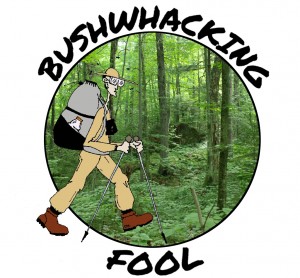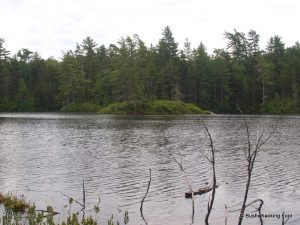
Island along Little Rock Pond
My sixth day in the southern Five Ponds Wilderness Area of the Adirondack Park starts out sunny with largely clear skies at an old camp site in the southwest corner of Beaverdam Pond. This is a welcome change from the previous two mornings that started out wet and unseasonably cool at both Negro Lake and Wilder Pond. Too bad the forecast for today calls for increasingly cloudy skies with a likely chance of afternoon thunderstorms.
I just hope I get to the Trout Pond lean-to on the Red Horse Trail before those thunderstorms arrive. Or, I will experience another wet day in a rather wet trip so far.
Although the morning looks promising weather-wise, I am unable to take advantage of it by getting an early start as my night at Beaverdam Pond was an unsettled one, leaving me feeling old and broken. Apparently, a small sapling and a large fern mound underneath my tarp led to me being contorted into shapes only a young person could endure. At least I did not sleep on my safety glasses like I did the previous night.
Section Stats:
Date: June 30, 2015
Length: 1.7 miles (1.7 total daily miles; 30.2 total trip miles)
Difficulty: Moderate
Along with the flora, the fauna contributed to my unsettled night’s rest in their own way. Barred owls called repeatedly, with me replying rather shabbily when inspired. Bullfrogs continued their cacophony throughout the night, never taking a break, at least while I was awake and trying to find a comfortable position. Not wanting to be left out, the beaver continued to slap his tail on the water, making it quite clear that it did not enjoy my company.
However, the prize for the most annoying wildlife encounter last night goes to the green frog that tried repeatedly to enter my shelter through the front door. No matter how much I tried, I could not dissuade it from jumping on the mosquito netting, which it did many times. Many. Times. At some point, it must have gotten it into its tiny head that it might be best to take another route. Or perhaps there were just many of the little buggers, as I placed my shelter on a green frog herd path.
As the minutes tick by, the time for reverie about last night draws to a close, especially if I want to avoid getting wet in those forecast thunderstorms.
The early morning greets me with cool temperatures and a great deal of fog. My view outside my shelter has some serious constraints, with the large ferns surrounding my tarp effectively blocking me from seeing much. Sitting up with my head at the mosquito netting shelter’s highest point, I can barely see the pond to the northeast, at least I could if it were not for the dense fog.
More importantly than the pea-soup fog is the lack of rain. For the first time in three days, the day greets me with a relative lack of moisture. No rain is good rain! Unfortunately, the situation is not likely to stay that way, so the dryness is bound to be short-lived.
Very short-lived if I do not get off my butt and start some bushwhacking while the going is good.
So, not wanting to waste these precious dry hours, I crawl out of my sleeping bag and start my morning chores, with a lot less enthusiasm that the relatively nice weather would warrant. Although wasting a little time to enjoy the lack of rain seems worthwhile, I know that the sooner I get up and going, the more likely I will reach the Trout Pond lean-to before any downpours lead to just another wet day in the backcountry.
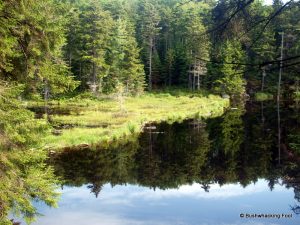
Beaverdam Pond dam
After finishing my morning chores, including breakfast and camp disassembly, it is time to head south to Little Rock Pond. Unfortunately, it is already nearly nine in the morning, so my time-wasting has already cost me an early start, not to mention burning the best weather hours of the day. After bushwhacking along Little Rock Pond, Witchhopple Lake is next on the itinerary, soon followed by a return to the Red Horse Trail. The day will end with a hike down to Trout Pond by trail, with a nice spacious, dry and empty lean-to waiting for occupation for a couple nights.
At least, I hope it is empty, or at the very least, has room for a single, stinky bushwhacker.
However, the first major obstacle remains the same beaver dam spanning the flooded channel I crossed just yesterday while getting here. When hiking along the channel’s shore, I notice a funny looking tree half submerged in the dark water and completely devoid of bark. With a single central stem that branches out to two subsequent stems, it resembles a tuning fork, or a long-legged person. Despite the odd log, it takes little time to cross the shabbily-built dam, and put some distance between myself and my campsite at Beaverdam Pond.
Although the forest is fairly easy going, with only minor ups and downs, scattered boulders abound. I hike around most of the rocks, and thus avoid the precarious footing they provide. However, a few of the flatter ones I go up and over, with the climb off them being the more difficult of the two.
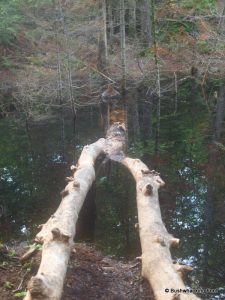
Long-legged Man-Log
Soon I approach a clearing, with the first clue of its presence being the light penetrating the trees before me. It takes me only a few minutes more before I find myself along the northern shore of a mid-sized pond. Many snags stand within the water, though most are short and stubby. A large nest in one tall snag suggests a great blue heron, or perhaps an osprey. A significant beaver lodge lies in the middle of the pond, signaling the presence of a resident aquatic rodent, while tree swallows and eastern kingbirds fly about, rapidly repeating their respective calls.
Whether this waterbody is part of Little Rock Pond or just an unnamed pond a short distance northeast of the larger pond remains unclear. It lies a short distance upstream from the large pond, though they are connected via an open, but beaver-dammed channel. Either way, it signals I kept the correct bearing from Beaverdam Pond, and I just need to proceed southwest to finally reach the main pond, turning northward temporarily if I reach any impassible obstacles (i.e. large wetlands) along the way.
And a few obstacles present themselves too. An open boggy area protrudes from this unnamed pond just a short distance to the southwest from my arrival location, while an even larger one connects to a few small islands in the northeast corner of Little Rock Pond. The first boggy wetland protrudes from the small pond soon after I begin bushwhacking to the southwest, but it proves to be a minor obstacle, taking only a short time to detour around it.
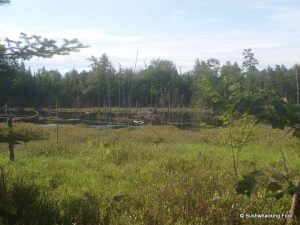
Small pond
Since time is of the essence with forecast thunderstorms in the afternoon, I reenter the forest for a time, attempting to cut off the boggy area in the northwestern portion of Little Rock Pond entirely. This idea works like a charm, as the forest is mostly mature hardwoods, making the bushwhacking a literal pleasant walk in the woods. My bearing should take me to a thin bay across from a foot-shaped peninsula along Little Rock Pond’s north shore, cutting off about a third of my bushwhacking along the large pond’s shoreline.
The hiking remains easy through the surrounding hardwood forest, allowing me to quickly reach the western edge of the boggy area I was attempting to avoid in the first place. A narrow opening in the trees allows for my first glimpse of Little Rock Pond, but more importantly a better view of the sky above it. Darkening overcast clouds are slowly taking over now, as the forecast storm system inches its way in from the west. I pick up my pace a little, hoping not to ruin my first dry day in the last several.
After a brief reentry into the surrounding forest to avoid some large boulders, I emerge at the pond’s narrow bay along its northern shoreline. However, there is no view of the open water, as the forested peninsula lies between the pond and myself. The only open water is the thin channel, which curves to the southeast one way and the southwest in the other, bordered on both sides by mature forest with beaver dams present in both directions, impeding what little flow that exists.

Channel
Although chock-full of some aquatic vegetation growing at the bottom of the channel, the water itself is surprisingly crystal clear. Some downed trees and half submerged rocks provide potential sunning opportunities for wildlife, with a green frog perching on a rock just a short distance off shore being a prime example. These objects make up for the lack of shoreline along the northern shore in some places, as a severely slopping rock slab disappears directly into the water.
With the overcast-filtered sunshine, along with the warming temperatures, the deer flies join their cousins, the mosquitoes, in menacing me when I stop to admire the channel. The flies repeatedly land on my hands, trying to gnaw into my flesh for a sweet taste of my blood. I do my best to prevent them, but an occasional sting signals my efforts are not completely up to snuff. Each bite bring more swearing and a wish that the carnivorous sundews repeatedly seen along shore where more effective at their task.
As I follow along the channel’s northern shore to the west, after a brief detour into the forest to avoid the rocky cliff, I begin to wonder about the channel’s origin. A beaver dam and some boggy areas at its western end, suggests the ground on the opposite shore is an island slowly transitioning to a peninsula. Exploring this strip of land captures my imagination, but unfortunately, with the increasingly dark skies and humid temperatures, my practical sense nixes that idea in its bud.
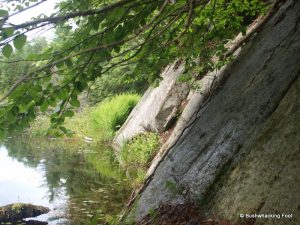
Rocky slab along channel
As I clear the island/peninsula, I decide to once again reenter the forest and cut off a slice of the pond’s irregular the north shore to save time. The pleasantry of the previous forest is no longer present however, with numerous boulders, downed trees and dense sapling undergrowth providing frequent opportunities to reevaluate my route. After briefly returning to the shoreline for a view, I remain in the forest until venturing out to the water’s edge for one more time before departing.
As I approach the western end of the pond, large, well-spaced eastern white pines dominate the surrounding forest. The almost park-like setting provides numerous opportunities for camping, with level ground and clearings due to beaver activity accentuating their appeal. Unfortunately, these sites are mostly too close to the shore to be legal, but I could see how the view could entice a regulation-compliant bushwhacker to bend the rules a little in this case.
But not me, of course.
My arrival at Little Rock Pond’s western end means only one thing, the bushwhack back to the Red Horse Trail is nigh. Now I just need to decide whether the thunderstorms are going to hold off long enough to revisit the beautiful Witchhopple Lake first or not.
I am feeling lucky.

Little Rock Pond’s western end
Affiliate Disclaimer: Some links and advertisements on this blog post and elsewhere on the Bushwhacking Fool may send you to a retailer’s website. If you chose to purchase any product on that site, this author may receive a small commission at no extra cost to you. These commissions provide compensation for the author’s time and effort necessary to provide the content at the Bushwhacking Fool. If you enjoy the content on the Bushwhacking Fool, please show your appreciation by purchasing products through links and advertisements on this site.
